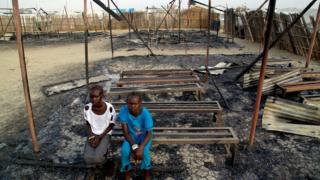10 toughest places for girls to go to school
Debates about schools in richer countries are often about the politics of priorities, what subjects should be given most importance, who needs extra help and what needs more public spending.
But for families in many developing countries questions about education can be a lot more basic – is there any access to school at all?
Figures from the United Nations suggest there has been "almost zero progress" in the past decade in tackling the lack of school places in some of the world's poorest countries.
A further report examined the quality of education, and the UN said the findings were "staggering", with more than 600 million children in school but learning next to nothing.
While in affluent Western countries, girls are often ahead of boys in academic achievement, in poorer parts of the world, particularly sub-Saharan Africa, girls are much more likely to be missing out.
And on the UN's International Day of the Girl, the development campaign, One, has created a ranking for the toughest places for girls to get an education.
Conflict zones
Across these 10 countries, most of those without school places are girls.
These are fragile countries, where many families are at risk from poverty, ill health, poor nutrition and displacement from war and conflict.
Many young girls are expected to work rather than go to school. And many marry young, ending any chance of an education.
UN figures indicate girls are more than twice as likely to lose out on education in conflict zones.
The rankings are based on:
- the proportion of girls without a primary school place
- the proportion of girls without a secondary school place
- the proportion of girls completing primary school
- the proportion of girls completing secondary school
- the average number of years girls attend school
- female illiteracy rates
- teacher training levels
- the teacher-pupil ratio
- public spending on education
For some countries, such as Syria, there was insufficient reliable data for them to be included.
Here are the top 10 toughest places for girls' education:
- South Sudan: the world's newest country has faced much violence and war, with the destruction of schools and families forced from their homes. Almost three-quarters of girls do not even make it to primary school
- Central African Republic: one teacher for every 80 pupils
- Niger: only 17% of women between the ages of 15 and 24 are literate
- Afghanistan: wide gender gap, with boys more likely to be in school than girls
- Chad: many social and economic barriers to girls and women getting education
- Mali: only 38% of girls finish primary school
- Guinea: the average time in education among women over the age of 25 is less than one year
- Burkina Faso: only 1% of girls complete secondary school
- Liberia: almost two-thirds of primary-age pupils out of school
- Ethiopia: two in five girls are married before the age of 18
A shortage of teachers is a common problem across poorer countries.
Last year, the UN said another 69 million teachers would need to be recruited worldwide by 2030 if international promises on education were to be kept.
The report says there are great economic dividends if girls can be kept in school.
And there are great gains for individuals, such as Florence Cheptoo, who lives in a remote village in Kenya and learned to read at the age of 60.
Gayle Smith, president of the One campaign, called the failures in education for girls a "global crisis that perpetuates poverty".
"Over 130 million girls are still out of school – that's over 130 million potential engineers, entrepreneurs, teachers and politicians whose leadership the world is missing out on."
More from Global education
- Modernising female voice for Qatar
- 'In school, but learning nothing'
- 10 university flashpoints over free speech
- What's it like to start reading at 60?
- 'Zero progress' on lack of school places, says UN
Ideas for the Global education series? Get in touch.

